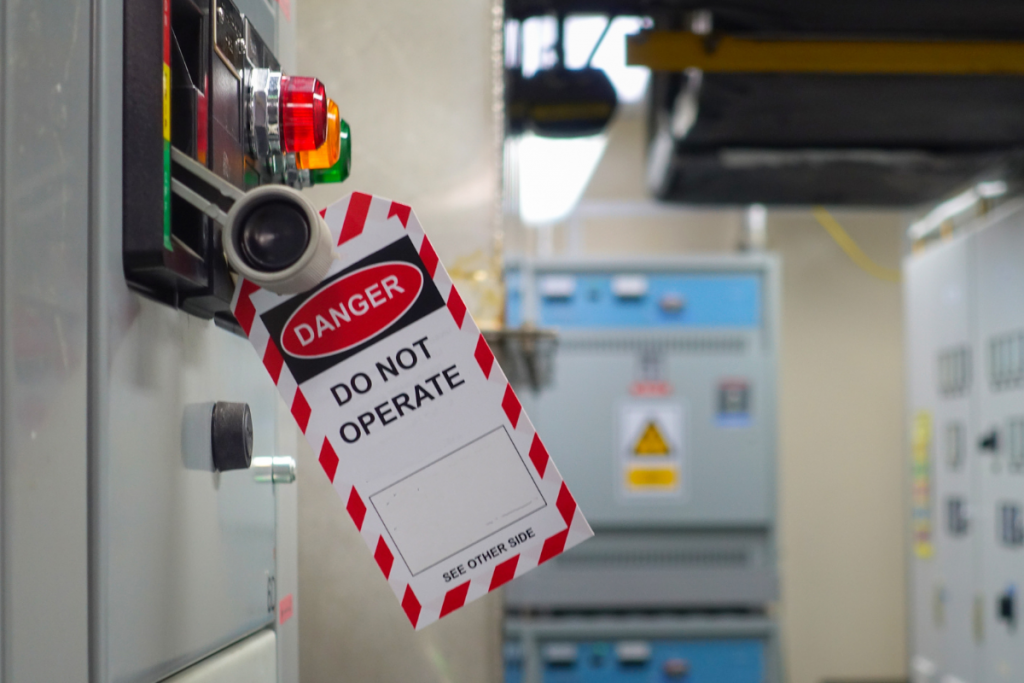It’s no secret that working in a food processing plant can be quite dangerous. In fact, the Bureau of Labor Statistics (BLS) has listed the food manufacturing industry as one of the most hazardous. A big contributor to workplace accidents is improper lockout/tagout (LOTO) procedures.
When production in a food processing plant is halted for the installation, servicing or maintenance of machinery and heavy equipment, there must be a LOTO procedure in place to prevent the machine from turning back on and injuring a worker.
The Occupational Safety and Health Administration (OSHA) maintains a standard for this vital control of hazardous energy that applies to various forms of energy, including: electrical, mechanical, hydraulic, pneumatic, chemical and thermal. For instance, in the refrigeration sector, the LOTO process would typically involve a pump-down procedure to prevent ammonia leaks.
LOTO violations can cause serious injuries, or even death. For example, at a facility in Ohio, a worker had to have part of her arm amputated after getting it caught in an auger that turned on while she was cleaning the machine.
These kinds of violations can also result in hefty OSHA citations, costing food and beverage plants tens of thousands of dollars. In fact, LOTO-involved citations are the most commonly issued by OSHA.
“In the period from October 2020 through September 2021 (the latest available), of the 1,188 violations issued by OSHA to food & beverage companies, 259, or 22%, were for LOTO violations,” according to Food Processing magazine.
4 Tips for preventing lockout/tagout-related accidents
LOTO procedures usually involve actual, physical locks and tags that are applied to energy sources like circuit breaker switches. This system is a much safer way to identify valve status than the old system of colored ribbons.
1. Develop and implement a stringent LOTO process
Your LOTO procedure should be part of your process safety management (PSM) program.
- Everyone on your team should familiarize themselves with it, even those in management.
- Stellar offers PSM compliance inspections, PSM program development and digital organization of documentation, and the National Grain and Feed Association offers a free training course that tackles the LOTO safety procedure.
- These procedures should be specific to the equipment your facility has on its operations floor. OSHA does not permit the use of a generalized procedure; you will be found non-compliant with possible fines.
2. Document your LOTO procedures
It’s not enough to have broadly written LOTO regulations included in your safety manual.
- OSHA can and will fine you if you do not have a written procedure as part of that safety manual that is specific to your plant and equipment.
- You must also provide documentation that you have trained your workers on these particular LOTO protocols.
3. Use the right equipment
OSHA has regulations for what can be considered an isolating device that reliably cuts power to equipment.
- Every person working on a piece of equipment should have his or her own lock as an added level of security. It’s not sufficient to rely on a coworker’s lock.
- There is a significant advantage to having a tag on the piping valve that gives your plant technician’s name and contact information for after-hour emergencies.
4. Make your lockout station accessible
The harder your lockout equipment is to reach, the less likely your employees are to use it.
- Set it up in a centralized location where workers can quickly and easily sign out their tags.
Creating a culture of safety
Efficiency usually has a tradeoff. What makes a plant highly productive can also make it more hazardous to its workers. For this reason, each worker should feel empowered to speak up when they feel they are being pushed to keep working despite unsafe conditions. Ultimately, everyone is responsible for his or her own safety.
Creating a culture of safety also means walking the walk. Managers should always demonstrate the behaviors they want to see their employees emulate.
Complacency is often at odds with safety. Schedule refresher training for new hires and veterans alike. Years on the job do not exempt you from the risk of an accident if you do not follow proper LOTO procedures.
Auditing your facility
In addition to the Environmental Protection Agency’s (EPA) mandatory audits conducted every three years, food processing plants should hire external professionals to audit their facilities. You may even need to hire an industrial hygienist to complete the audit if you use a specialized system, like ammonia refrigeration.
If your facility fails to comply with LOTO procedures, your employees can be seriously injured. The company could be fined for willful negligence and this could ultimately affect operations companywide – not just at the offending facility. For these reasons, every facility should be two things: safe and compliant.
Want to learn more about how to set up an ironclad lockout/tagout procedure? Email us at foodforthought@stellar.net or give us a call at 800.488.2900.



